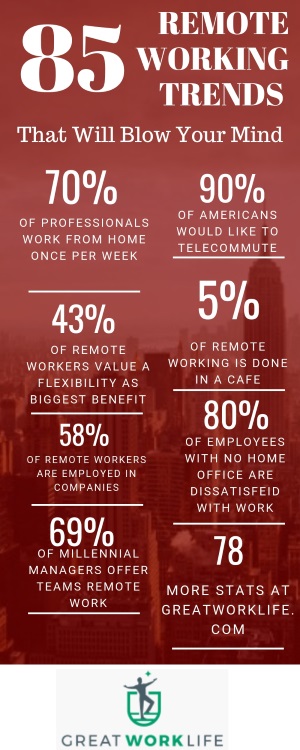Going to the office is fast becoming a thing of the past for many of the world’s population. Interestingly, the available data indicates working remotely or outside the office is becoming the norm in many professions.
A combination of new technology, changing attitudes about work, and labor shortages in some fields are making remote work more accessible than ever before. Both employers and employees are embracing remote work because of its benefits.
Remote work offers many benefits, including lower costs, increased efficiency, higher productivity, greater employee satisfaction, higher morale, and reduced stress. Given these benefits, employers of all sizes embrace remote work.

Here are 78 statistics and commentaries that show the popularity of remote work and offer a glimpse of the growing popularity of remote work.
1. Working from Home is the New Normal
Working remotely is the new normal for many professionals. For instance, CNBC reports that 70% of professionals surveyed by office service provider IWG said they work remotely. Moreover, 53% of the professionals IWG surveyed claim they work remotely at least once weekly.
2. 71% of Americans are Currently Working from Home
The number of people working remotely is rising. In 2022, 7 out of 10 American employees have been working from home since the coronavirus outbreak, up from 43% in 2016. This is up from 39% in 2012.
3. Remote Working is the Fastest Growing Workforce
Remote work is one of the fastest-growing areas of the workforce. Global Workforce Analytics estimates that the number of remote workers in America grew by 140% between 2005 and July 2018. Moreover, the number of remote workers grew ten times faster than that of traditional employees and self-employed.
4. 40% of Employers Offer Remote Working
Employers are more receptive to working from home and telecommuting than ever before. Global Workforce Analytics estimates that 40% of American employers offered some remote work opportunities in 2018.
5. 93% of Employees Not Offered Remote Work
Finding remote work is still a challenge for many employees. Global Workforce Analytics estimates remote work is not an option for 93% of American employees. Only 7% of the employees surveyed were offered remote work opportunities.
6. 70% of USA Workers Could Work From Home
Many more people could work remotely if employers gave them a chance. Pew Research estimates that 70% of American employees hold jobs that they could perform remotely in 2021.
7. 25% of People Occasionally Work From Home
One in four Americans occasionally works remotely. Global Workforce Analytics estimates that 20% to 25% of the US workforce telecommutes regularly.
8. 54% Say They Would Like to Work from Home
Most Americans will do remote work if offered the chance. Pew research also found that 80% to 90% of Americans want to telecommute. Specifically, the average American wants to work from home two to three days a week.

"When You Stop Learning, You Stop Living" SkillShare Makes Learning Easy. Skillshare Is Our #1 Rated Learning Platform With Great Lessons On:★★★★★ Creating: Photography, Film-Making, Music, Graphic Design & Coding ★★★★★ Building: Leadership, Communication, Entrepreneurship & Marketing ★★★★★ Thriving: Personal & Professional Development, Productivity, Time Management "Skillshare is like Netflix for learning. I take a course every time I need a new skill. With over 30,000 courses to choose from, I always have something to learn." Barry D. Moore - Founder: GreatWorkLife.com |
9. Office Desks Only Occupied 50% of the Time
Many more people could be working remotely than the data indicates. Global Workforce Analytics estimates that most Fortune 1000 company employees are only at their desks 40% to 50% of the time, and most leave their desks at least half the time.
10. Remote Workers Earn More
Remote workers earn quite a bit more than average Americans. Global Workforce Analytics estimates that 75% of remote American workers earn over $65,000 annually. In contrast, The Balance estimates the median yearly salary for the average American was $47,060 a year in the first Quarter of 2019.
11. Professional Remote Workers Earn Less
However, remote-working professionals could earn slightly less than those who stay in the office. The Balance calculates the average American professional earns $66,820 a year. On the other hand, most remote working professionals earn just $1,820 less than the average American professional.
12. 60% of Home Workers Want More Time at Home
Significantly, most remote workers want to increase the amount of remote work they do. Pew Research found that 60% of remote workers want to increase the amount of remote work they do. Moreover, only 34% of remote workers were satisfied with the amount of work they performed.
13. 94% of Remote Workers Recommend It to Others
Most remote workers are satisfied with their jobs and situations. The State of Remote Work 2018 found that 90% of remote workers want to keep working remotely for the rest of their careers. Additionally, 94% of remote workers surveyed said they recommend remote work for others.
14. 66% of Remote Workers are Full-Time
Nearly two-thirds of remote workers work remotely full-time. 70% of those surveyed for The State of Remote Work 2018 Report were full-time remote workers. Interestingly, only 30% of remote workers, less than one-third, spent some time in the office.
15. 43% Say flexibility is the Biggest Benefit
A flexible schedule is the most valued benefit of remote work. 43% of remote workers told Buffer they consider flexible schedules the biggest benefit. Also popular were spending time with the family (15%), the opportunity to travel (12%), and the work environment (11%).
16. Only 4% of People Say Avoiding Office Politics is a Benefit
Remote workers do not dislike the office and coworkers as much as they commonly believe. Buffer’s State of Remote Work 2018 survey found only 4% of respondents cited avoiding office politics as a reason for telecommuting.
17. 21% of Remote Workers Experience Loneliness
Conversely, most remote workers miss their interactions with coworkers. Notably, 21% of The State of Remote Work 2018 respondents cited loneliness as their “biggest struggle.” Additionally, another 21% of respondents admitted that not being able to collaborate or cooperate with other workers was a “big struggle.”
18. 86% of Home Office Workers are Motivated
Motivation is not a problem for 86% of remote workers. The State of Remote Work 2018 states only 14% of remote workers admit to having problems staying motivated. Consequently, most remote workers can easily motivate themselves at home.
19. 78% of Remote Workers Work From Home
Not surprisingly, home is still the most popular office for the world’s remote workers. 78% of The State of Remote Work 2018 respondents listed home as their primary work environment. Other popular workplaces include the office 9% of remote workers still perform most of their labors at the office.
20. Only 5% of Remote Workers Work from a Cafe
The popular stereotype of the remote worker sitting in a coffee shop sipping a late at her laptop is a myth. Only 5% of remote workers told The State of Remote Work pollsters they work in cafes.
21. Only 7% of Remote Workers Use Coworking Spaces
Coworking spaces are not very popular among remote workers. Just 7% of the telecommuters surveyed for The State of Remote 2018 said they used coworking spaces.
22. 80% Work While They Travel
Over 8 in 10 remote workers work while they travel. 81% of the people surveyed for The State of Remote Work 2018 said they worked while they traveled. However, less than 50% of the telecommuters surveyed say they spent more than 4% of their time traveling. Consequently, most remote workers rarely leave home.
23. Only 28% of Remote Workers are Freelancers
Most remote workers are not freelancers. Instead, The State of Remote Work 2018 found that 58% of remote workers were employees of one company. Only 28% of the remote workers surveyed were freelancers. However, 45% of those with regular jobs admitted to freelancing.
24. 63% of Employers Offer Working from Home
Employers are becoming more receptive to remote work. Upwork’s 2018 Future Workforce report claims that 63% of American employers offer some sort of remote work option.
25. 82% of PwC Employees Work From Home
Some companies are more receptive than others. For example, The Harvard Business Review reports that Dorothy Hisgrove, the Chief People Officer at PwC Australia, claims that 82% of her employees occasionally work remotely.
26. 32% of People Quit Because of No Remote Working
More people are quitting their jobs because of their inability to work remotely. Flexjobs estimates that 32% of professionals, nearly one-third, admit they quit a position because of a “lack of flexibility” in 2017.
Interestingly, the number of people who quit jobs because of a lack of flexibility is growing. Only 13% of respondents admitted to quitting jobs because of a lack of flexibility in 2013. Thus, the number of people switching jobs for more flexibility grew by 17% in four years.
27. More Women Prefer Remote Working
Women are far more receptive to remote work than men. Flexjobs claims that companies with female CEOs were four times more likely to offer remote work opportunities than those with men.
28. 60% of Telecommuters Work a Fixed Scheduled
Most remote workers work fixed hours. A Talent LMS survey finds that 60% of telecommuters work a fixed schedule. Thus, many remote employers still follow a standard nine-to-five shift.
29. 67% of Remote Workers Want More Training
Remote workers do not think they are getting enough training. 67% of remote workers told Talent LMS they would like more training.
30. 70% of Remote Workers Get Training
However, most companies do offer training for remote workers. Talent LMS reports that 70% of remote workers receive direct training from their employers.
31. 50% of Telecommuters Take Online Courses
Telecommuters do want to learn, however. 50% of remote workers take online courses, 22% use their phones to learn, and 13% attend webinars, TalentLMS estimates.
32. 31% of Remote Workers Have a Home Office
Less than one-third of remote workers have a home office. According to Talent LMS, 31% of telecommuters own a home office.
33. 16% of People Work From the Bedroom
The living room is the second most popular space for working from home. 27% of remote workers say they work from the living room. Other popular locations include the bedroom (16%), the dining room (13%), and the kitchen (10%).
34. 25% of Staff Work With The TV On
Oddly, 25% of remote workers, or one-fourth, admit they work with the television on. Conversely, 21% of telecommuters prefer to work in complete silence.
35. Remote Worker Onboarding is Important
Not welcoming new remote employees into an organization could be a big mistake. Only 20% of those who supervisors did not welcome told TalentLMS they were satisfied with their positions. However, 41% of those welcomed onboard claimed to be satisfied.
36. 52% User Communications Apps
Over half, or 52%, of remote workers, say they use communication apps frequently in their work.
[Related Article: 39 Golden Rules for Success In Remote Working]
37. Skype & Zooms Are The Most Used Communication Tools
Skype is the most popular communication app, according to 27% of TalentLMS respondents.
38. Top 10 Remote Working Roles
The ten most popular work-from-home positions in America are accountant, engineer, instructor, writer, consultant, program manager, project manager, customer service representative, business development manager, account executive, and Flexjobs claims.
39. A Job By any Other Name
There is no set title or name for remote positions. Popular descriptions of the role include; “remote job,” “telecommuting job,” and “virtual job.” Flexjobs
40. The Best WFH Companies
According to Forbes contributor Alexandra Talty, the top work-from-home company in the United States is the machine-learning firm Appen. Appen provides high-quality training for machine learning, including language services.
Talty reveals that other top work-from-home companies in the United States include Lionbridge, VIPKID, Liveops, Working Solutions, Amazon, TTEC (Teletech), Kelly Services, Concentrix, and UnitedHealthGroup.
Well-known companies that offer work-from-home opportunities include Intuit, Williams-Sonoma, Aetna (now part of CVS Health), Dell, Robert Half International, Hilton, Anthem Inc., SAP, Amgen, ADP, Human, Red Hat, Wells Fargo, Gartner, VMWare, Salesforce, JPMorgan Chase, Carlson Wagonlit Travel, Kaplan, Cisco Systems, Houghton Mifflin Harcourt, Xerox, The Hartford, Phillips, GitHub (now part of Microsoft), General Dynamics, Lenovo, American Express, Johnson & Johnson, and Rackspace.
41. Only a Few Government Agencies Offer Remote Work
A few government agencies are offering work-from-home opportunities. The US Department of Commerce, the Commonwealth of Virginia, and the State of Washington are among Talty’s top 100 remote working organizations.
42. 69% of Millennial Managers Allow Remote Working
Younger managers are more receptive to remote workers. Specifically, Yahoo Finance estimates that 69% of Millennial Managers (those under 38) and 59% of Generation X managers (those under 52) allow remote work on their teams.
However, most managers will accept and support employers who work remotely. Yahoo Finance reports that 58% of Baby Boomer (over 53) managers allow team members to work remotely.
43. By 2028, 73% of Firms Will Allow Remote Work
Working remotely will become the norm within a decade. Gallup predicts that 73% of employers, or two-thirds, will have some remote employees by 2028.
44. 90% of People Believe Remote Work Improves Morale
The vast majority of people want more remote work and telecommuting opportunities. The Staples Workforce Survey found that 90% of employees believe more flexible work arrangements and schedules increase worker morale.
45. 67% Would Quit If Work Arrangements Were Less Flexible
Many employees now value the opportunity to work flexibly more than their jobs. 67% of employees told Staples they would consider leaving their jobs if work arrangements became less flexible.
46. Office Workers Only Work 32% of the Time
Interestingly, most employees could spend over two-thirds of their time away from the office. Workers told Staples they only spend 32% of their time at the office. Thus, the average worker could reduce her workload by two-thirds and still get just as done. Consequently, the office may not be needed for productivity.
47. Only 27% of Millennials Spend 100% of Time in the Office
Younger people are even less likely to spend time at the office. Staples calculates that only 27% of American millennials (those under 38) spend all their work time in a traditional office.
48. 62% Lack the Ability to Work Remotely
Incredibly, 62% of Americans cannot still work remotely. In November 2017, Staples estimated that only 38% of American employees could work remotely.
49. 6 Million Americans Work from Coworking Spaces
More Americans than ever are seeking alternatives to traditional workspaces. For instance, Staples estimates that 6 million American office workers used coworking spaces in 2017.
[Related Article: 26 Proven Advantages of Telecommuting For Employers]
50. One Office Interruption Costs 23 Minutes of Productivity
Interruptions at work are far more costly than you might think. The Motley Fool claims it takes the average officer worker 23 minutes to recover from a minor interruption.
51. Distractions Cost 2 Hours Per Day
Being alone and away from the office could make you far more productive. For instance, The Motley Fool claims employers estimate that the average employee loses one to two hours of productivity daily because of coworker distractions. Therefore, allowing working from home and working remotely could make companies more productive.
52. 35% of Time Is Spent in Meetings
Meetings are one of the greatest threats to worker productivity. Specifically, middle managers spent 35% of their time at work in meetings. In addition, the average upper management executive spends 50% of her time in meetings, The Muse claims. Consequently, being away from the office during meetings is one of the biggest benefits of remote work.
53. Only 50% of Employees Know Their Goals
Communication between management and employees is the hardest challenge facing remote and in-office workers. Gallup estimates that only 50% of employees know what their managers expect. Consequently, many remote workers do not understand their role in the organization. Additionally, telecommuters can have difficulty expanding their roles and meeting unfilled needs in the organization.
54. Managers Need Frequent One on One Meeting With Staff
Managers must have frequent conversations with all workers, including remote employees, for an organization to succeed. Gallup notes: “A flexible culture requires frequent manager conversations about an employee’s short-term and long-term goals.”
55. Gig Workers are the Faster Growing Area of Remote Work
Short-term freelance positions, or gigs, are one of the fastest-growing remote work areas. Pew Research estimates that 24% of Americans made money from the platform economy in 2018.
 Audiobooks Are Food for the Mind Inspiration, Education & Relaxation Have you discovered the joy of listening?★★★★★ Audible: Review Winner - Best for Price, Library Size & Original Content. ★★★★★ Blinkist: Review Winner - Best Audiobook Summary Service. ★★★★ Audiobooks.com: Best For Unlimited Audiobook Listening. "As a 10-year member of Audible, I have a library of 300+ audiobooks. The best thing is, with a few clicks, I can return any book within 12-months. I also subscribe to Blinkist; with 5,000 15-minute audio-summaries, I can consume knowledge and learn new concepts fast." Barry D. Moore - Founder: GreatWorkLife.com |
56. 8% of Americans Earned Money With Online Platforms
Platforms such as Upwork and Amazon’s Mechanical Turk are becoming one of the most popular ways to find remote work. Pew Research estimates that 8% of American adults earned money by doing a job or task they found online in 2018.
57. Uber & Lyft Are The Least Popular Remote Jobs
Ride-hailing services like Uber and Lyft are still among the least popular remote jobs. Pew Research estimates only 2% of Americans drove for ride-hailing apps in 2018.
58. 16% Aged 18 to 29 Use Digital Platforms to Work
Younger people are more likely to use digital platforms to seek work. Pew estimates that 16% of Americans aged 18 to 29 used digital platforms to seek work or gigs in 2018.
59. 22% Making over $30,000 Per Year Seek Work On Digital Platforms
Higher-income and middle-class people are more likely to seek remote work through platforms. Pew calculates that 22% of Americans making over $30,000 annually are likelier to seek work through digital platforms.
60. 56% of Gig Workers Admit Gig Work is Essential Earnings
The gig economy is now vital to many Americans’ financial survival. Pew Research finds that 56% of gig economy workers admit gig work is essential, or important, to their financial survival. Moreover, 49% of gig workers admit digital tasks are essential to their financial survival.
61. 68% of Gig Workers Have Regular Jobs
More full-time workers are doing remote side hustles than is commonly believed. Pew found that 44% of gig economy workers admit they are employed full-time. In addition, 34% of gig economy workers are part-time employees.
In fact, over two-thirds of gig economy workers have a regular job. Pew found only 32% of gig workers said they were not employed.
62. 68% of Gig Workers Call Themselves “Independent Contractors.”
Interestingly, over one-fourth of Americans now view online platforms like Uber and Upwork as their “boss.” In particular, 26% of gig workers tell Pew they consider themselves “employees” of gig platforms. However, 68% of gig workers call themselves “independent contractors.” Therefore, many people are confused about their employment status.
63. 86.5 Million People Could Be Freelancing by 2028
Over half the population could be working remotely by 2028. Statista predicts that 50.9% of the US workforce, or 86.5 million people, could be freelancing in 2028. Thus, over half the population will do gig work in less than ten years.
64. There are 56.7 Million Freelancers in the United States
There are now 56.7 million freelancers in the United States, Quartz reports. Moreover, according to estimates from the Freelancers Union and Upwork, the number of freelancers in America grew by 3.7 million between 2013 and 2018.
65. 70% of Freelancers Train Online
Freelancers could be better trained than the rest; 70% of full-time freelancers participated in online skills training. However, only 49% of full-time employees engage in such training. Thus, freelancers have a serious advantage over those in the office.
66. Freelancers Better Trained Than Full-time Workers
Interestingly, freelancers have a more positive view of learning than full-time workers. 93% of freelancers value skills training and on-the-job education over a college degree. Thus, freelancers could be more willing to learn and easier to train than full-time workers. That could give freelancers an edge over employees finding work in new or growing fields.
67. American Freelancers Are Far Harder Workers
American freelancers are far harder workers than most people give them credit for. Upwork estimates that American freelancers worked 1.07 billion hours a week in 2018, up from 998 million in 2016.
68. 61% of Freelancers Freelance By Choice
More and more remote workers are choosing to go freelance. 61% of freelancers told Upwork they were freelancing by choice in 2018. That number grew from 53% in 2014.
69. 42% of Freelancers Say They Value Flexibility
Like remote workers, freelancers say flexibility is one of their favorite perks. 42% of freelancers tell Upwork that freelancing “gives them more flexibility than a traditional employer.” Consequently, traditional employers must offer more flexibility to lure freelancers back into the fold.
70. 64% of Freelancers Find Work Online
The amount of work available to freelancers is increasing. Notably, 64% of freelancers told Upwork they found work online in 2018. However, only 42% of freelancers found work online in 2014.
Consequently, employers must try to satisfy remote workers and keep them on board. Since remote work is becoming easier to find, more workers could transition to freelancing.
Conversely, some employers will use the fear of workers going freelance as an excuse to curtail remote working. For instance, some employers could limit remote work to highly skilled or productive employees.
71. American Business Is Reliant on Freelancers
American businesses are becoming more reliant on freelancers. According to Upwork, US freelancers worked 1.07 billion hours a week in 2018, compared to 998 million hours a week in 2014.
72. 51% of Freelancers Say They Will Never Go Back To Regular Jobs
Getting freelancers to go full-time is getting harder. Upwork finds that 51% of freelancers admit “no amount of money” will get them to return to a traditional nine-to-five job.
73. 77% of Freelancers Say They Have a Better Work/Life Balance
Freelancing provides a high level of job satisfaction. For instance, 77% of freelancers tell Upwork they have a “better work/life balance” than those working in the office.
74. 84% of Freelancers Rate Lifestyle Higher Than Income
Lifestyle matters most to freelancers. Notably, Upwork claims that 84% of full-time freelancers prioritized lifestyle over income. However, only 64% of traditional workers prioritize lifestyle.
75. 63% of Freelancers Feel Anxious
Freelancers are likely to worry about their future. Particularly, 63% of freelancers tell Upwork they feel anxious about all the time and tasks they have to manage.
76. 53% of Freelancers are Politically Active
Freelancers are likelier to be engaged in their community and country than full-time workers. Notably, Upwork found that 53% of freelancers described themselves as “politically active, “compared to 34% of traditional employees.
77. 77% of Freelancers Are Optimistic About Gig Work
Most freelancers are becoming more optimistic about the future of independent contracting. To elaborate, 77% of freelancers were optimistic about the future of gig work in 2014. That number jumped to 87% in 2018.
Therefore, it will be harder than ever for employers to get freelancers to sign on as full-time workers at some point in the future. A likely outcome is that many employers will simply stop offering full-time work to contractors.
78. 57% of CEOs Say Remote Work Helps Reduce Attrition
57% of CEOs report that digital technologies are helping to reduce attrition rates and improve employee retention.
Remote Work Statistics & Trends Summary
These statistics provide an interesting glimpse of the future of work and business everybody needs to consider. We can make a few generalizations about the future workplace with the data presented.
First, the workplace of the future is not likely to be an office or physical building. Instead, many more people will work remotely or digitally and never see their coworkers or employers.
Second, under those circumstances, more organizations will forgo the expense of building brick-and-mortar offices and have everybody work remotely. Third, some employers will require remote work because it is cheaper and more productive.
Fourth, the distinctions between freelancers and full-time employers will disappear. Some organizations could offer freelancers the same benefits as full-time employees to retain their services. For instance, they are offering freelancers health insurance or paid vacations. In addition, many organizations will offer all workers the possibility to freelance.
The main lesson from the data is that everybody needs to learn to work remotely. The statistics show that remote work is the future of employment, so everybody needs to get used to it.
[Related Article: GetResponse Email Marketing Software – Review Winner]













Let’s hope the laws for acceptable noise levels are addressed to accommodate this new trend. Yapping dogs, screaming children, a garage band – even another loud tenant – can cause disturbances to doing remote work, sometimes to the point of losing a customer. In the original work space, there is a controlled atmosphere without such interruptions. But now, remote workers are at the mercy of their surroundings. Noise laws need to reflect this new era business model, perhaps define noise by decibel levels, regardless the time of day or night. Remote workers come in night shifts, too!